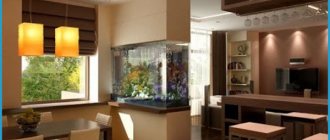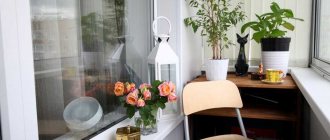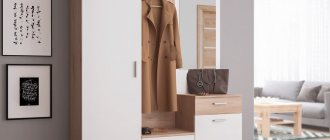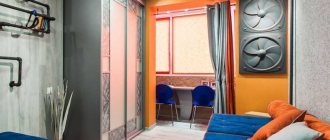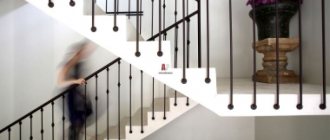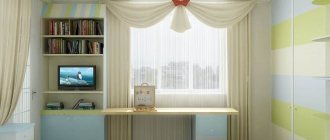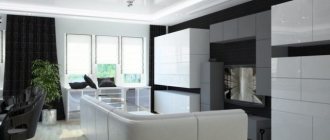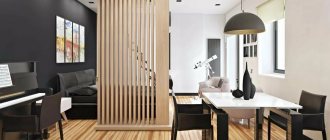SHARE ON SOCIAL NETWORKS
FacebookTwitterOkGoogle+PinterestVk
First of all, stair railings are designed to ensure safe movement. In addition to stairs, they are also necessary for other potentially dangerous structures: balconies, terraces, verandas. Most often, wood, metal, and durable glass are used for manufacturing. To make the staircase look harmonious, its constituent elements are made in the same style. At the same time, one should not forget to “adjust” the design to the surrounding interior.
The main task of stair railings is to ensure safe movement
Types of stairs: basic requirements for organizing the structure
The type of staircase in a private house or two-story apartment should be considered at the stage of construction or renovation. When arranging a space, you need to understand that the staircase is a massive structure that occupies a prominent place in the room. For this reason, it is important not only to take into account safety aspects, but also to select the optimal design, shape and material of manufacture so that the product becomes an extension of the surrounding interior. There are these types of stairs in the house:
The following types of stairs can be installed in the house: straight, spiral, combined and marching
- straight;
- rotary;
- screw;
- curvilinear;
- combined;
- curved;
- marching.
A separate group includes aerial stairs, which are steps mounted with one edge into the wall. This option looks laconic and will be an excellent addition to an interior in a high-tech style or other modern style. As for design issues, when choosing a design you should rely on the following basic recommendations:
- If the staircase is large and located at a large slope, small platforms should be arranged every 8-12 steps so that you can rest and catch your breath during the ascent.
- The optimal width of the step is considered to be 80 cm. This distance is enough for 2 people to safely pass each other on the stairs.
- For average height, a comfortable step height for climbing is considered to be 15-20 cm. The parameter should be selected based on the average height of the occupants of the room.
- The minimum depth of the step should not be less than 25-30 cm.
- When creating a landing, you need to take into account that it must be wider than the flight of stairs.
- You should not design a staircase with a slope of more than 45 degrees, because otherwise the product will not be considered safe. The optimal indicator is an angle of 25-35 degrees.
- The material for constructing stairs should not be flammable. Even if wood is used for manufacturing, it must be treated with special fire retardants.
A step width of about 80 cm is optimal
Expert advice! The angle of rise of the stairs and railings directly depends on the area allocated for the installation of the structure. If space is very limited, it is better to give preference to a spiral staircase. Numerous twists and turns will help smooth out a large slope.
Railing material
Stair railings are made from different raw materials. The choice of the most suitable substance depends on the type of building (private house, public institution or institution), installation location (outdoors, in the garden, indoors), general interior, exterior, and personal preferences of the owner. The main materials used are: metal, wood, plastic, glass, concrete. There are also combined options. Each of these types is characterized by its own characteristics and has advantages and disadvantages.
Metal
For the production of metal profile railings, aluminum, stainless steel, steel, cast iron, and brass can be used. The first two options are the most common, so let’s look at them in more detail:
- Aluminum structures. When choosing this material, you should consider its softness. Under the influence of heavy loads, it can become deformed and even break, so such fences should not have additional decorative elements. Among the advantages of aluminum are:
- light weight;
- simple installation;
- neutrality to moisture, respectively, resistance to corrosion;
- attractive appearance;
- natural shine;
- low cost.
- Stainless steel. This is a durable raw material that allows you to make a reliable, comfortable fence that can withstand heavy loads. Among the advantages are:
- long service life;
- moisture resistance;
- safety and practicality in use;
- easy care;
- aesthetics, suitable for many modern styles, for example, high-tech, modern, minimalism;
- environmental friendliness and hygiene;
- the ability to combine with glass, wood, plastic.
In principle, stainless steel railings have the same characteristics as aluminum railings. However, they are heavier, cost an order of magnitude more, and over time, numerous scratches and chips appear on their surface. Aluminum does not have these disadvantages, but it loses in aesthetic terms.
Natural wood
Wood is a natural material that does not lose its relevance. A staircase structure, partially or completely consisting of wooden elements, will fill the house with warmth and bring comfort to it. This is an ideal option for those who want to give their home a natural look and are concerned about environmental friendliness. For the production of fences, oak, larch, ash, beech, and pine are used.
Each breed has its own characteristics. Oak is the most durable lumber. It looks very expensive, its service life is more than 10 years. The choice of one type of wood or another depends on its price and the required quality. Among the main advantages of natural wood are:
- versatility, wood is compatible with almost all interior styles;
- the substance is warm and pleasant to the touch;
- reliability and strength;
- environmental safety;
- attractive appearance;
- the ability to create the most unusual shapes and use carved elements;
- the presence of a natural pattern;
- simple installation activities.
Flaws:
- high cost, especially of carved products;
- wooden structures are susceptible to rotting, even the use of special antiseptics and varnishes can solve this problem for a short time;
- Low quality wood is not durable; if handled carelessly, chips and cracks may appear on the surface.
Glass
Glass railings look unusual. They are quite rare in comparison with wooden and metal fences. And although at first glance the products may seem insufficiently reliable, this is not so. They are made of impact-resistant material that can withstand significant loads. Such structures can be installed even by families with children without fear for their safety.
In the production of fencing, tempered glass or triplex is used, which can be transparent, matte, tinted, stained glass, corrugated, printed, or have LED backlighting. The quality of the material guarantees a long service life of the product, and over time, cracks or chips will not appear on its surface. Despite the fact that the substance is self-sufficient, railings are often supplemented with wooden, metal, chrome, and plastic elements.
Advantages:
- attractive, unusual appearance;
- visual increase in space;
- durability;
- complete neutrality to moisture;
- resistance to temperature changes;
- a large selection of different design options;
- easy installation.
Flaws:
- high price;
- Difficult to maintain; stains remain on the surface.
Plastic
The structures must withstand significant loads, so hard plastic is used in their production. This material allows you to create railings of almost any shape, which have a wide range of colors. Finished products can be installed both indoors and outdoors. The cost of such fences is low, but they are not popular. The main advantages include:
- resistance to aggressive environments, alkalis, detergents;
- a wide variety of shapes;
- light weight;
- the material does not conduct current;
- warm to the touch;
- does not require additional painting or treatment with impregnations.
Flaws:
- low strength, breaks or cracks with a strong impact;
- low-quality raw materials are environmentally unsafe and release toxins;
- low frost resistance;
- at temperatures below 15° it becomes brittle;
- fades when exposed to direct sunlight.
Wrought iron railings
Forged structures are one of the most attractive metal products. They are able to highlight the original interior of a country house or apartment. They can be installed not only in private homes, but also in public institutions, for example, in restaurants, hotels, cafes. The cost of the fence directly depends on the total weight of the structure, the number of decorative elements, and the type of decoration.
Another important factor is the type of forging, which can be done hot or cold. The first production method is more labor-intensive, but allows you to obtain original, unique products, the price of which is very high. Elements obtained in the second way are made according to a template, using special devices, and are not exclusive.
Advantages:
- long service life;
- the ability to create a unique design;
- resistance to various influences;
- strength and reliability;
- ergonomics.
Flaws:
- high cost, as manual labor is used;
- long production times;
- installation complexity;
- increased risk of injury due to the presence of sharp parts;
- heavy weight.
Concrete and stone
Due to their heavy weight, concrete and stone railings are practically not used indoors; they are intended for outdoor installation. If we talk about natural stone, then such designs are extremely rare. And although marble or granite looks luxurious, their cost is simply prohibitive. In addition, processing the material takes a lot of time, so in most cases artificial analogues are used.
Concrete fences are easier to produce and are made by pouring concrete mixture into molds. They are characterized by durability, withstand high and low temperatures well, and have a low price. But the material also has its drawbacks: relatively heavy weight, unattractive appearance, high porosity. Without periodic painting, the fences begin to collapse under the influence of moisture.
Combined
Combined fencing is a product that combines different materials. They are filled with glass, wooden crossbars, forged elements, etc. Thanks to the combination of different substances, the designs have a unique appearance, are compatible with any style, and are suitable for decorating both classic and modern interiors.
For the production of racks, stainless steel is most often used, which goes well with any raw material. The included handrails can be made of hardwood or high-quality plastic. Plexiglas or triplex covers the space between the steps and handrails. It is also appropriate to use ordinary black metal, decorative elements made of brass, copper or bronze.
What are railings: the feasibility of installing them
Railings are an essential element of any staircase. In addition to the fact that the products increase the comfort of use of the entire structure, they provide additional safety and make the staircase more durable and stable. It is thanks to the fences that you can give the staircase an original and complete look.
It is a mistake to think that handrails are needed only by older people, children, or those who have problems with the musculoskeletal system: it is generally accepted that these categories of people have difficulty with stability and safe movement along the steps.
In addition to providing safety, railings also serve an aesthetic function.
Most designers argue that even healthy adults prefer to use stairs equipped with handrails and railings because they create a feeling of safety. In the event of a fall or other unforeseen situation, a person will grab onto the railings.
In addition to the fact that stairs with railings are more convenient to use, the elements also serve an aesthetic function, because they can be given an attractive appearance. Fences are made in any color, decorated with carvings or forged elements, depending on the interior, angular or rounded details are thought out.
A variety of materials will help give fences an individual appearance; it can be wood, plastic, metal or glass. The railings can be attached to the steps or mounted into the wall - everything will depend on your imagination, the features of the installation location and the chosen interior design.
The railing can be mounted into the wall or attached to the steps
What other elements does the stair railing consist of?
So, in addition to the railings, which provide convenient descents and ascents of the stairs, the fencing elements include:
- handrails;
- balusters.
Handrails are essentially the part of the railing that is located at the top of the fence. It is the handrails that a person holds on to when using the stairs. Interestingly, if you lean on the handrails during a long climb, you can remove up to 20% of the load from your legs. These fencing elements are fixed to balusters; they can be located on one or both sides.
Helpful advice! It is recommended to install handrails on both sides if the width of the staircase exceeds 125 cm. When the structure is installed along the wall, you can attach the handrails directly to the wall surface.
Handrails and balusters are the main elements that make up the railings
Balusters are support posts that are used to secure the fence to the surface of the step. In addition to performing a decorative function, balusters increase the load-bearing capacity of the staircase. Fillers are installed between them. According to their design, racks are divided into the following types:
- Classic. They are the most common option, consisting of vertically installed or inclined figured rods.
- Solid. If you look at the photo of balusters for stairs, you will notice that this option is considered the safest for homes where children live and there are pets. It will not be possible to crawl between adjacent elements, because they are installed close to each other.
- Crossbars. A simple design consisting of the intersection of vertical and horizontal slats.
- Patterned. Here everything will depend on the imagination of the performer, because it is appropriate to give the filling any artistic form. A fence made of balusters made using various monograms looks beautiful in a classic interior.
To create unique products of their kind, it is permissible to use a combined design of fencing. Sometimes the installation of balusters on the stairs is replaced with a bowstring, which is a horizontal fence fixed under the handrails parallel to the stairs. Some railings may also have a cap, the so-called curbstone, which is installed at the beginning and end of the span instead of balusters. The plug is a purely decorative part that does not carry any functional load.
The combined design of the railings will help make the fence unique and original.
This is interesting! On trading floors you can find ready-made prefabricated or one-piece versions of railings. If you decide to make custom-made products, you need to be prepared for waste, both monetary and time. But an exclusive staircase, made in a single copy, will always be the pride of the owners.
Basic norms and standards: what should be the width and height of the railings on the stairs
Properly selected stair railings will ensure the safest possible movement along the steps, thereby reducing the risk of injury. Sometimes you can find a design option for stairs without railings. They look very unusual, but many note that using them is quite inconvenient. You should know that certain standards have been developed regulating the dimensions of elements. As for the height of the staircase railings, it is recommended to select the best option depending on the average height of the occupants of the home.
Most experts will recommend experimentation when designing handrails. To do this, you need to stand comfortably on a step and extend your arm forward, then measure the distance from your palm to the step. It is the resulting value that will be the optimal height of the handrail. Traditionally, the minimum height is 90 cm, the maximum handrail is raised by 110-115 cm.
The optimal height for stair railings is 90 cm
If small children live in the house, you should not attach an additional stationary handrail, because within a year the child will grow up. It is better to install a temporary element that will run parallel to the main one. Other fencing options:
- The width of the staircase handrail usually varies from 3 to 7 cm. It is important to choose a diameter so that the part fits comfortably in your hand.
- The distance between individual balusters can be any, because in this case everything depends on the artistic intention of the owners of the building. Typically the figure ranges from 50 to 70 cm.
Other standards that railings and fences in buildings must comply with
In accordance with GOST standards, as well as in accordance with the state SNiP, it is recommended to adhere to the following parameters:
- stair railing height – 90-100 cm;
- the distance between adjacent posts is 60 cm;
- mandatory presence of filling between balusters;
- the gap between the wall surface and the handrail is 7-10 cm;
- the distance over which the rounded end of the railing should protrude relative to the last step is 30 cm.
There are also separate standards for the load for which stair railings in a private home and public buildings must be designed. All data was obtained on the basis of tests carried out in accordance with SNiP 2.01.07-85. Thus, when creating structures, it is recommended to rely on the following load parameters:
Depending on the purpose of the institution, fencing must withstand a load in the range of 30-150 kg/m²
- social institutions: children's institutions, hospitals and sanatoriums - more than 80 kg per square meter of fence;
- office buildings – 30-80 kg/m²;
- residential buildings – 80-100 kg/m²;
- premises designed for sporting events, stadium stands - more than 150 kg/m².
Other mandatory safety requirements (according to SNiP):
- It is mandatory to install handrails if the staircase consists of more than three steps;
- there should be no sharp corners or protrusions on the fence;
- it is necessary that the balustrade completely frames all flights of stairs.
Separate recommendations are also made regarding railings and railings for stairs in children's institutions (in accordance with the standards of the 1.256-1 series):
- an additional handrail should be installed at a height of 50 cm from the floor;
- for greater convenience, it is recommended to use rotating brackets for the railings during installation, allowing you to change the angle of inclination;
- It is strictly forbidden to use glass filling between balusters;
- the clearance between the posts and balusters is no more than 10 cm;
- fence height – 1.2-1.8 m.
According to SNiP, it is necessary to install railings if the staircase consists of more than three steps
Helpful advice! If people who use wheelchairs live in the house, a ramp is installed instead of stairs, and railings must be installed on both sides.
Before you start designing stairs, you should familiarize yourself with the recommendations regarding the arrangement of structural parts of the railings, which are given by experts in this field:
- The number of balusters is determined by the number and dimensions of the handrails. If the base consists of flexible and heavy materials, then the number of supports should be such that sagging of the profile or excessive overload of the supports can be prevented.
- According to the standard, balusters are installed on each step, but if they are wide, it is possible to install several supports on one surface. When children live in the house, the distance between the balusters should be such that the baby cannot stick his head between them.
- If the flight width is more than 1 meter, the staircase is equipped with railings on both sides.
- Wooden railings for stairs are allowed to be installed only in private residential buildings.
- In office buildings, it is better to install a bowstring instead of balusters.
- When arranging the space of a shopping and entertainment complex, it is imperative to use at least three crossbars for railings.
Related article:
Wooden railings for stairs: when natural beauty brings comfort
Subtleties of creating railings. Design tips. Instructions for the manufacture of individual parts. Types of installation.
Fencing for stairs: types of designs, materials for manufacturing
As the previous information shows, there are a large number of ways to arrange railings for decorating stairs. The choice of a specific option will depend on the location and structural features of the flight of stairs. In general, the following types of fencing for stairs in a house are distinguished:
Stair railings can be installed both inside and outside the house
- Interior. As the name implies, such structures are located indoors. In most cases, interior stairs are made of glass or wood, and the shade is selected depending on the surrounding interior.
- Exterior. This includes outdoor stair railings framing a veranda, porch or balcony. It is necessary that the material can withstand various weather conditions well. Outside residential premises, metal and concrete are used for fencing.
The most popular materials used for fencing include:
- Metal. Basically, aluminum is used for the production of railings, which has an impeccable shine, or forged steel, which has unique decorative properties. Forged products are often made to order.
- Tree. The most popular material for creating stair railings in a private home, because wood is warm to the touch and fits into most interiors.
- Polymers. The main material here is plastic, mounted using special fasteners. The main advantage of such products is their low cost.
- Glass. Glass railings for stairs are mainly used to organize space in shopping or office centers. Only tempered glass is suitable for creating structures.
- Concrete. It is found mainly when decorating the entrance to a building or on main staircases. In this case, you can purchase ready-made structures in production or cast them yourself directly during construction. For work you will only need special forms.
The most popular materials for making railings are metal, wood, glass and concrete
Fences made by combining materials stand out. The most common option is a combination of forged or aluminum balusters with wooden elements.
As for the shape of the railing, in this case everything will depend not only on the installation location of the structure, but also on the material used to create the fence:
- Classic designs are made from wood. Most often, balusters are straight, massive columns with rounded edges, often decorated with carvings.
- Metal stair railings are usually not so massive, but the products are richly decorated with decorative elements.
- Glass is not a very malleable material (unlike wood and metal), so this type of fencing will have a strict and laconic design.
Features of using wooden stair railings
Despite the fact that the building materials market does not stand still and is constantly replenished with new products, wood does not lose its relevance, so such railings continue to be actively purchased. This is due to the fact that this material is of natural origin and is not capable of harming the health of others.
The main advantage of wooden fencing is its attractive appearance.
The main advantages of wooden fencing:
- attractive appearance;
- pleasant structure and texture;
- ability to withstand mechanical damage;
- resistance to negative environmental influences.
It should be noted that all these benefits can be increased if wooden structures are periodically treated with special solutions. Pre-treated wood can be used not only indoors, but also outdoors.
It’s quite easy to choose the appropriate option for the job, because trading platforms offer products made from various types of wood, differing in design, color and quality. But fences made from different types of wood will differ in cost. Pine products are considered the cheapest. Oak structures are considered elite and durable, which is why they are characterized by a high price.
Wooden balusters are used to decorate interior staircases in houses more often than others. They are attached both to steps and to wooden handrails. Depending on the type of staircase, balusters differ in type and size. The size of the standard section is 45x45 mm: the wider the staircase, the greater this figure. Sometimes there are balusters whose cross-section is larger than 50x50 or 60x60 mm.
The size of the standard section of a wooden baluster is 45x45 mm
A significant disadvantage of wooden stair railings is that the material, due to its natural origin, is subject to swelling and shrinking, especially if the ambient air conditions are constantly changing. This can reduce the strength of fences, and exterior stairs can become deformed and change color.
Why are stainless steel and aluminum stair railings popular?
Fences for stairs made of stainless steel or aluminum are widely used in the organization of exteriors and interiors. Nickel-plated or brass options, which were very popular at the end of the last century, are installed a little less frequently. It was then that fencing made of brass and nickel was used to furnish office and shopping centers.
This is interesting! Metal railings have long been widely used due to their high consumer characteristics and versatility, which allows such structures to be used with equal success both indoors and outdoors.
Among the main advantages of metal railings for stairs are:
Stainless steel fencing has become very popular lately.
- Long service life. Handrails and railings made of metal, with proper care, can last up to 50 years.
- Attractive appearance. Metallic shine can decorate any modern and even classic interior.
- Easy care. The products do not require constant maintenance, which consists of tinting or varnishing elements. There is no need to apply antifungal or fireproofing solutions, as is the case with wood. The only thing that needs to be done is to wipe the fences with a damp cloth from time to time.
- Resistance to destruction. Steel and aluminum, like other metals, are resistant to the appearance and development of rust; it is this fact that allows such structures to be installed everywhere.
- Price. Stainless steel stair railings will cost much less than glass or forged products, but they are more expensive than wooden ones.
In addition to a large number of advantages, fencing also has some disadvantages. Thus, many users note that with active use of the structure, the ability of the material to withstand mechanical damage decreases. The surface is covered with small scratches and chips, which can be felt to the touch, and the joints become loose.
The advantages of stainless steel stair railings are long service life and attractive appearance
Advantages and disadvantages of wrought iron handrails for stairs
Wrought iron railings for stairs are considered an expensive but high-quality option. At the same time, the finished structures are distinguished by exceptional beauty and sophistication. Several forging technologies are used to make railings:
- Cold. The result of the work is simple forms - twisted rods. As a rule, such railing options are found on verandas or other outdoor structures.
- Hot. It requires significant labor and time, but the result is railings of unusual and ornate shapes. It is hot forging that allows you to create the most complex designs, but you need to be prepared for large financial costs.
The main advantages of forged stair railings:
- Resistance to aggressive environmental influences. Fences withstand the effects of precipitation, temperature fluctuations and humidity well without losing their appearance. In addition, they are not subject to mechanical damage.
- Long lifespan. Forged products in most cases, even after 100 years, will look beautiful and attractive.
- Unique design. Forging is used mainly to fulfill individual orders. Thus, it is possible to decorate the staircase with exclusive railings.
The only disadvantage of forged railings is the high cost, because the entire manufacturing process is an exclusive handicraft.
Wrought iron railings for stairs are made by cold or hot forging
Features of plastic and glass railings for stairs
Glass stair railings are an excellent solution for modern interiors in high-tech, minimalism, fusion and other styles. Due to the fact that only strengthened (tempered) glass is suitable for creating railings, the products are endowed with a large number of advantages:
- Ease and high speed of installation. You can install fencing yourself without using any complicated tools. By and large, the entire installation process will take no more than a few hours.
- Large assortment. There are a variety of material options available on trading platforms, which are characterized by additional advantages, such as sound insulation and frost resistance. More expensive glass railings for stairs are explosion and heat resistant.
- Durability. Glass structures can be used for as long as metal ones - about 50 years.
The advantages include the possibility of quick dismantling. If any of the sections becomes deformed or loses its integrity, there is no need to disassemble the entire structure, because all sections are located autonomously.
The best solution for interiors in high-tech, minimalism, and fusion styles are glass railings for stairs
Among the disadvantages of glass railings for stairs for a country house, it is worth noting the need for constant maintenance. If the glass is not regularly wiped, then there will be stains, fingerprints and other contaminants on the surface, spoiling the appearance of the entire structure. Another disadvantage is the high cost of finished products.
To produce composite railings, hard plastic is used, mounted on a special clamp. The main advantage of polymer fencing is its low cost, because cheap plastic is used to manufacture the products. It is important to understand that the advantages of plastic fencing do not end there. Other advantages include:
- easy maintenance, because the plastic is easy to remove stains and polish;
- no need for regular paint or varnish treatment.
At the same time, a significant disadvantage of plastic fencing is the low resistance of the material to mechanical stress and shock. If there is strong pressure or impact, the integrity of the structure will most likely be damaged.
The main disadvantage of glass railings is the need for constant maintenance.
Stone and concrete railings for terraces and other outdoor structures
Fences made of stone or concrete are mainly suitable for decorating outdoor structures: external flights of stairs, porches or verandas. The material is distinguished by its increased ability to withstand external influences, has significant weight, and is cold to the touch. It is for these reasons that concrete fences are not used inside houses.
Concrete can easily withstand negative atmospheric influences and looks monumental and presentable in appearance. With its help, you can highlight the exterior of the house and emphasize the high status of the owners. Depending on the specifics of production, there are the following types of stone balusters:
- Carved. As a rule, they are made by hand, which allows the elements to be given exquisite and varied shapes.
- Spot. A common version of fencing that has rounded shapes. A distinctive feature is the presence of point supports, the horizontal section of which has the shape of a circle.
- Hewn. Balusters are distinguished by smooth edges and angular shapes; the horizontal section of the posts resembles polygons.
For the design of street fencing, the best solution would be materials such as concrete and stone.
As for materials, other stones are also suitable for organizing railings:
- marble;
- Dagestan stone;
- granite.
All of these options are quite heavy, so a lighter and easier to process artificial stone is often used as a base. But the most durable fencing is obtained only by using granite, since this stone is one of the hardest rocks.
Important! Stone handrails and railings look attractive and expensive. But it should be taken into account that structures have a significant impact on flights of stairs, which must be taken into account when creating staircase designs.
It is recommended to combine stone fences with plank or metal stairs. Such a combination will play up the design and give the room a cozy and comfortable look.
Stone railings look very attractive and expensive
Types of fencing
Various products are made from natural materials or artificial raw materials, which allows you to choose exactly the subtype of fencing that best matches the staircase structure and the overall design of the house.
All types of products are divided into two large groups.
street staircase
Exterior products are designed to be installed outside the home, for example, on a porch or terrace.
Home construction
Interior models are always used indoors.
Wooden
Wooden railings are great for indoor installation. Absolutely environmentally friendly material, which increases the level of safety. Wood perfectly resists abrasion and mechanical stress.
Simple wooden railings
Carved installations
Combination with other materials
Due to the fact that there are a huge variety of tree species, every homeowner can find an option that suits their soul and wallet.
Metal
Structures made of stainless steel and aluminum base are constantly in demand, as they have a number of important characteristics. The products have a long service life, as they are capable of fulfilling their intended purpose for more than 50 years in a row. Additionally, a modern touch is added to the overall design of the room, making it more modern.
Steel structures
Unlike wood, metal does not require regular maintenance or coating with specialized substances. Due to the stainless steel coating, the railings can be washed regularly with water.
Aluminum railings
Metal fencing railings are equally well suited for internal and external installation, as they can easily withstand temperature changes and precipitation. The level of humidity for steel or aluminum does not matter and does not affect operational parameters in any way.
Forged patterns are practically a form of art, since various ornaments create a unique design while being fully consistent with their purpose. You can choose a finished product or make an individual design to order.
Forged sections
There are two forging options, depending on which you can choose a more budget-friendly option.
Hot forging
Hot forging involves pre-heating the steel and then tapping it with a hammer.
Cold production
Cold production involves bending blanks using special equipment. This method is inconvenient because the patterns will be simpler and less effective.
Glass
Although glass is associated with fragility, this is not the case in this case. Glass fences are created from durable thickened raw materials, perfectly complementing handrails made of any type of material.
Glass inserts
Ready-made inserts are quick to install and convenient to hold during fastening. Among all the types offered by modern stores, there are fireproof, frost-resistant, and sound-insulating variations.
Decorative glass
Glass products do not deteriorate over time and can be used for up to half a century or more. If any section is damaged, it is possible to make a local replacement without disassembling the entire assembly system, removing only the damaged fragment.
Replacement of damaged part
But you should be prepared for the costs: such railings are expensive and not so easy to maintain.
Plastic
Plastic restraints, otherwise called polymer, are an inexpensive type of railing: in comparison with other raw material options, this product is a significant leader. It also does not require additional costs, work in the form of applying a special coating or treatment with special liquids. It is enough to keep the surface clean.
PVC railings
Wear-resistant structures can easily withstand minor damage, but strong impacts can damage them irreversibly. On the other hand, with a strong desire, it is possible to ruin almost any type of material.
Concrete
Concrete decoration is used extremely rarely, which is directly related to the total weight of the structure and its final cost. At the same time, concrete railings are highly durable, making the structure powerful and stable.
Concrete products
They are used not only for rooms, but also for porches, since the substance easily tolerates different temperatures and high humidity without losing its performance and decorative qualities.
It is possible to further decorate the entire staircase structure by installing carved balusters made in various shapes.
Point models assume different degrees of thickening with rounded shapes, and their horizontal section is always round.
Spot options
Hewn options are columns with clear edges, an angular appearance and a polygonal cross-section.
Hewn products
The strength of products increases due to the addition of natural elements: granite, marble and so on.
Adding natural ingredients
The railing installation process is shown in the following video:
Why are the upper supporting elements of the railing needed: fences made in various versions
In order for the railings to be comfortable and safe to use, they must be equipped with handrails, which are made in different forms and using different materials.
As for the shape, the handrails are:
- round and oval;
- rectangular and square;
- corner;
- rounded.
The material is selected depending on the purpose, features of use and location of the staircase. If we talk about the porch, here you can most often find forged, chrome-plated, aluminum and other metal stair railings.
Handrails made from PVC can easily imitate any surface, but they are not as resistant to external influences. The main advantage is the high plasticity of the material, which allows you to give the elements any, even the most unusual, shape. To do this, you will need a hair dryer or other device that blows warm air. PVC handrails are also characterized by their low price.
Wrought iron railings with wooden handrails are the most popular railings for stairs
For many years, wood has been the most popular material for handrails due to the special comfort that wooden elements provide. Some people decorate wooden stair railings with their own hands, using artistic cutting, methods of aging surfaces, and applying special solutions.
Handrails are also classified according to the method of fastening. Some people mount the elements above the bowstring, but sometimes the handrails perform a load-bearing function. Handrails are attached to balusters in various ways: using anchors or self-tapping screws, or by welding. For installation on a wall or along a staircase, special cast brackets are used that allow you to grasp the bar from any side, including the end.
If you want to emphasize the individuality and unusualness of the interior, they resort to creating handrails of non-traditional shapes from scrap materials:
The material for handrails is selected depending on the purpose, location and features of use of the stairs
- Rough handrails made from untreated timber will fit perfectly into the interior of the chalet. This option will help place accents in the room and emphasize the unusualness of the interior.
- In a modern loft or minimalist style, railings made of branches in combination with PVC look appropriate.
- A nautical or rustic style is well emphasized by a rope or thick rope. In this case, this option can be performed at the dacha or in a private house.
Upper support elements
Railings always end with handrails on which people will lean when ascending or descending. Here, the imagination of designers and owners is practically unlimited, since the variety of colors and basic raw materials allows you to find an excellent solution for each specific situation.
What are the shapes and main material
The shape of the supports can be different: round, square, rectangular, triangular, rounded or angular.
Rectangular view
The choice of design should be consistent with safety requirements, the style of the room and be combined with balusters or other types of inserts.
Combination
You can use products from different raw materials: metal, wood, PVC. The latter are comparable in characteristics to metal, but in appearance they strongly resemble wood. Unlike wood, plastic handrails will not change size depending on the level of air humidity, and are easy to maintain.
Where to attach
The supporting elements are installed above the string of the structure, that is, the handrail will be placed on top, completely covering the edge of the inserts or vertical beams.
Standard mount
The second option is an additional installation, which is located in the middle of the space between the upper handrail and the step and acts as an additional supporting part. This is done to make it easier for children to move around.
Additional support
The third installation method involves installation with a load-bearing function, that is, the handrail will be the main part, and the inserts will simply be an addition.
Load-bearing function
And usually the supports are simply attached from above to firmly reinforced sections.
Non-standard approach
If there is an opportunity to do something unusual, it is better to take it. An excellent example would be forms that completely imitate tree thickets, creeping shrubs, intricately curved or spiral lines.
Backlight
Increased decorativeness
Changing the installation location
Installing lighting will help make using the stairs more comfortable at night. These can be small spotlights or LED strip.
Installation on walls also falls into the category of non-standard solutions.
